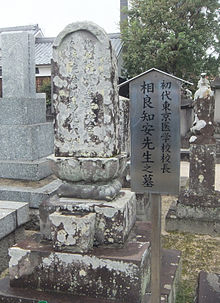|
Sagara Tomoyasu   Sagara Tomoyasu (相良 知安, 1836–1906)[1] was the third son of a surgeon in the feudal domain Saga (nowadays Saga Prefecture), Japan. Among his childhood friends was Etō Shimpei (1834–1874) who lived nearby and also became one of the influential figures of the Meiji Restoration. After receiving an education in traditional disciplines and Dutch-style medicine in local domain institutions, Sagara was dispatched to Nagasaki where he continued his medical studies under the Dutch doctor Anthonius Franciscus Bauduin (1820–1885)[2] and was taught English by the Dutch-American missionary Guido Verbeck. After the resignation of the last shōgun the Meiji government took control over the medical institutions of the Tokugawa regime and assigned Sagara Chian and Iwasa Jun from Echizen to draft a program for the new system of medical care and education. In 1870 Sagara recommended Germany as the model for Japan's medical modernization. After heavy struggles with proponents of British medicine, Sagara's concept was adopted, and in 1871 the first two German teachers (Benjamin Karl Leopold Müller and Theodor Eduard Hoffmann) arrived in Yokohama. For several years Sagara was involved in medical administration as chief of the Medical Affairs Bureau in the Ministry of Education. He also served as the head of Tokyo Medical School No. 1 that later became the Medical Faculty of the University of Tokyo, After retiring from his various positions, his life deteriorated quickly. Having left his family in Saga, he died alone from influenza in 1906. When an Imperial envoy arrived with a monetary offering to the departed spirit (saishiryō), people in the neighborhood could not understand why the envoy of the emperor had come to the home of such a poor old man. Sagara's grave is at the Jōun Temple (Jōun-in) in Saga. His posthumous Buddhist name (kaimyo) summarizes his life: The man who had a strong will and carried out his belief (鉄心院覚道知安居士). A monument honoring Sagara was raised at the University of Tokyo in 1935. Its inscription was drafted by Ishiguro Tadanori, a physician in the Imperial Japanese Army. Literature
References
|